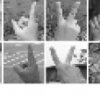Free Online Productivity Tools
i2Speak
i2Symbol
i2OCR
iTex2Img
iWeb2Print
iWeb2Shot
i2Type
iPdf2Split
iPdf2Merge
i2Bopomofo
i2Arabic
i2Style
i2Image
i2PDF
iLatex2Rtf
Sci2ools
ICPR
2004
IEEE
2004
IEEE
Analysis of Rotational Robustness of Hand Detection with a Viola-Jones Detector
The research described in this paper analyzes the in-plane rotational robustness of the Viola-Jones object detection method when used for hand appearance detection. We determine the rotational bounds for training and detection for achieving undiminished performance without an increase in classifier complexity. The result ? up to 15? total ? differs from the method's performance on faces (30? total). We found that randomly rotating the training data within these bounds allows for detection rates about one order of magnitude better than those trained on strictly aligned data. The implications of the results effect both savings in training costs as well as increased naturalness and comfort of vision-based hand gesture interfaces.
Computer Vision | Hand Appearance Detection | ICPR 2004 | In-plane Rotational Robustness | Viola-Jones Object Detection |
| Added | 09 Nov 2009 |
| Updated | 09 Nov 2009 |
| Type | Conference |
| Year | 2004 |
| Where | ICPR |
| Authors | Mathias Kölsch, Matthew Turk |
Comments (0)

